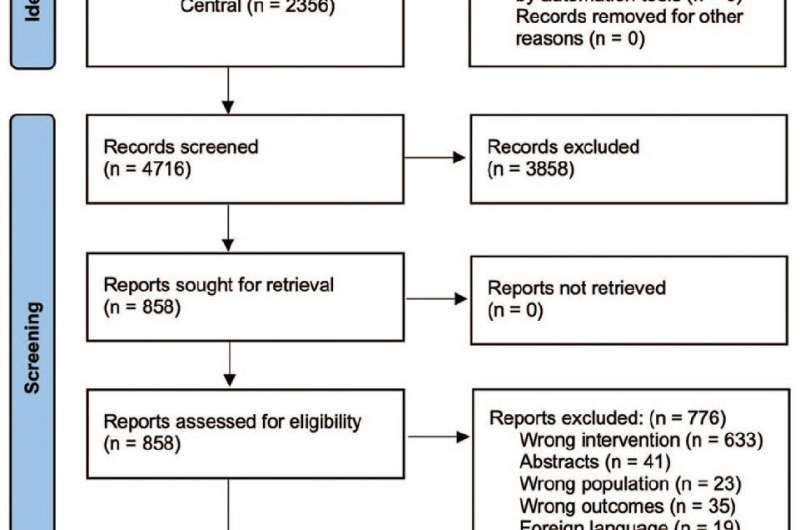Study identification and selection flowchart. Credit: Journal of Dental Research (2023). DOI: 10.1177/00220345221139230
A recent study published in the Journal of Dental Research (JDR) has compared the effectiveness of ten pharmacological interventions in order to develop guidelines for acute pain management after tooth extraction in adults.
North America is amid an opioid crisis, which is a leading public health and safety concern. In dentistry, many patients are prescribed opioids for the first time to manage acute postoperative pain after dental impaction surgery, which often results in prescription of an excess number of opioid pills, thereby increasing the risk of misuse, abuse, and addiction.
Of over half a million dental patient visits between 2011 and 2015, 29% of prescribed opioids exceeded the recommended morphine equivalent for appropriate management of acute pain and over half exceeded the recommended days of supply.
The current clinical practice guidelines lack evidence-based guidance on effective management of acute dental pain. The National Academies' report entitled "Framing Opioid Prescribing Guidelines for Acute Pain" highlighted the need to formalize evidence-based alternatives to opioid analgesics in a clinical practice guideline.
The study by Anna Miroshnychenko from McMaster University Faculty of Health Sciences and colleagues involved systematic review (SR) and network meta-analysis (NMA) to assess the comparative effectiveness of ten different pharmacological interventions for the management of pain subsequent to simple and surgical tooth extraction, and pain associated with pulpitis or its complications.
This SR was conducted to inform the 2022 evidence-based clinical practice guidelines produced by the American Dental Association (ADA) Council on Scientific Affairs, the ADA Science & Research Institute (ADASRI) and the University of Pittsburgh's and the University of Pennsylvania's Schools of Dental Medicine in partnership with the United States Food and Drug Administration (FDA) for the management of acute dental pain.
The study concluded that, based on moderate and high certainty evidence, in individuals undergoing surgical tooth extractions, the interventions classified as the most effective for pain relief were ibuprofen 200-400 mg plus acetaminophen 500-1,000 mg, acetaminophen 650 mg plus oxycodone 10 mg, ibuprofen 400 mg, and naproxen 400-440 mg.
Further, NSAIDs with or without acetaminophen result in better pain-related outcomes than opioids with or without acetaminophen (except acetaminophen 650 mg plus oxycodone 10 mg) or placebo. Future research should focus on the assessment of ibuprofen 200 mg plus hydrocodone 5 mg, hydrocodone 5 mg plus acetaminophen 300-325 mg and tramadol 37.5 mg plus acetaminophen 325 mg through randomized clinical trials.
More information: A. Miroshnychenko et al, Acute Postoperative Pain Due to Dental Extraction in the Adult Population: A Systematic Review and Network Meta-analysis, Journal of Dental Research (2023). DOI: 10.1177/00220345221139230
Journal information: Journal of Dental Research
Provided by International Association for Dental Research
























